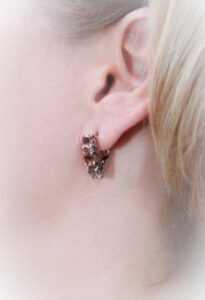In the world of body modification, piercing has been a popular form of self-expression for centuries. From earlobes to eyebrows, people have found creative ways to adorn their bodies.
One such piercing that has gained attention in recent years is the Rhino Piercing or Rhinoceros piercing. This unique and intriguing piercing not only adds a touch of individuality but also carries a rich cultural history.
In this article, we’ll explore the world of Rhino Piercing, from its origins and procedures to aftercare and common misconceptions.
Understanding Rhino Piercing
What is Rhino Piercing?
Rhino Piercing is a distinctive form of body modification that involves piercing the fleshy part of the nose. Unlike traditional nostril piercings that go through the nostrils, Rhino Piercing is done through the septum, the cartilage that separates the two nostrils. The piercing is so named because it resembles the horn of a rhinoceros, which adds to its unique appeal.
Origins of Rhino Piercing
Many also refer to it as Rhinoceros piercing around the world but it is essentially the same thing.
Rhino Piercing has a rich history that dates back centuries. It is deeply rooted in various cultures and has different significances across the globe. Some of the most notable origins and meanings include:
Native American Culture: Among some Native American tribes, the Rhino Piercing, often made of bone or wood, is seen as a symbol of strength and courage.
Indian Culture: In India, Rhino Piercing, known as the “septum piercing,” is a traditional ritual performed on young girls as a coming-of-age ceremony.
African Cultures: Several African communities practice Rhino Piercing as part of their cultural heritage, signifying various aspects of identity and spirituality.
Modern Popularity: In the modern world, Rhino Piercing has gained popularity as a unique and fashionable body modification choice.
The Rhino Piercing Procedure
Consultation
Before getting a Rhino Piercing, it is essential to schedule a consultation with a professional piercer. During this meeting, you can discuss your piercing goals, examine potential jewelry options, and address any questions or concerns you may have.
The Piercing Process
The Rhino Piercing procedure typically involves the following steps:
Sterilization: The piercer will thoroughly clean the area to be pierced, ensuring a sterile environment to prevent infections.
Marking: A skilled piercer will mark the precise location where the piercing will be placed, taking into consideration your unique anatomy and aesthetic preferences.
Piercing: Using a sterilized needle, the piercer will create a small hole through the septum. This process may cause a brief but manageable discomfort.
Jewelry Insertion: After piercing, the chosen jewelry, often a small hoop or captive bead ring, is inserted.
Aftercare Instructions: The piercer will provide you with detailed aftercare instructions to ensure a smooth healing process.
Pain and Healing
It’s natural to wonder about the pain and healing process associated with Rhino Piercing. The pain level is subjective and varies from person to person. However, many individuals describe it as a momentary, sharp pinch during the piercing process. As for healing, Rhino Piercing typically takes about 6-8 weeks to fully heal. During this period, it’s crucial to follow the aftercare instructions provided by your piercer.
Caring for Your Rhino Piercing
Proper aftercare is vital to ensure your Rhino Piercing heals without complications. Here are some key steps to follow:
Cleaning: Gently clean the piercing with saline solution twice a day to prevent infection.
Avoid Touching: Refrain from touching your piercing with dirty hands to reduce the risk of contamination.
Rotate Jewelry: Occasionally rotate the jewelry to prevent it from sticking to the piercing.
Avoid Swimming: Avoid swimming in pools or hot tubs during the healing period to prevent bacterial exposure.
Changing Jewelry: Wait until your piercing is fully healed before changing the jewelry.
Common Misconceptions about Rhino Piercing
It’s Extremely Painful
While Rhino Piercing may cause momentary discomfort during the piercing process, many people find the pain to be bearable and quickly forgotten.
It’s Only for a Specific Gender
Rhino Piercing is a form of self-expression that is not limited by gender. It can be enjoyed by anyone, regardless of their gender identity.
It Causes Breathing Difficulties
A well-done Rhino Piercing should not obstruct your ability to breathe. Piercers take great care to ensure the placement does not interfere with your nasal passages.
It Leaves a Permanent Hole
If you decide to remove your Rhino Piercing, the hole may shrink or close over time. However, some individuals may experience a small scar.
It Requires Excessive Maintenance
While proper aftercare is necessary, Rhino Piercing does not demand excessive maintenance. With careful cleaning and attention, it can heal without complications.
Rhino Piercing Jewelry
Variety of Choices
One of the most exciting aspects of Rhinoceros Piercing is the wide range of jewelry options available. From classic, minimalistic designs to more elaborate pieces, there’s something to suit every style and personality.
Common choices for Rhino Piercing jewelry include:
Captive Bead Rings: These rings feature a removable bead that encircles the septum. They come in various sizes and materials.
Horseshoe Rings: These rings are shaped like a horseshoe and come in different materials and sizes, allowing you to customize your look.
Clickers: Clicker jewelry offers a convenient hinge mechanism for easy insertion and removal. They often come in unique designs.
Seamless Rings: Seamless rings create a sleek and continuous look without a visible opening, providing a clean and subtle appearance.
Septum Retainers: For those who need to conceal their Rhino Piercing for work or formal occasions, septum retainers offer a discreet solution.
Material Matters
Selecting the right material for your Rhino Piercing jewelry is essential for comfort and safety. Some of the recommended materials include:
Surgical Steel: Known for its durability and hypoallergenic properties, surgical steel is a popular choice for initial jewelry.
Titanium: Lightweight and non-reactive, titanium is an excellent choice for those with sensitive skin.
Niobium: Another hypoallergenic option, niobium is available in various colors, allowing for personalized aesthetics.
14k Gold: If you’re looking for a touch of luxury, 14k gold jewelry is an elegant option, but it should be reserved for healed piercings due to its weight.
Rhino Piercing Pros and Cons
Rhino Piercing is an intriguing and unique form of body modification that has gained popularity for its distinctive appearance and cultural significance.
However, like any body modification, it comes with its own set of advantages and disadvantages. If you’re considering getting a Rhinoceros Piercing or are simply curious about the pros and cons, let’s explore them in detail.
Pros of Rhino Piercing
Unique Aesthetic Appeal
One of the most significant advantages of Rhino Piercing is its unique and eye-catching appearance. The septum piercing, resembling the horn of a rhinoceros, sets you apart from the crowd and can be a powerful form of self-expression.
Rich Cultural History
Rhino Piercing has deep-rooted cultural significance in various parts of the world. Embracing this piercing can connect you to traditions and symbolism from Native American, Indian, and African cultures, among others.
Versatile Jewelry Options
Rhino Piercing offers a wide range of jewelry choices, allowing you to personalize your look. From simple hoops to intricate clickers and seamless rings, you can find jewelry that suits your style and personality.
Minimal Pain during Piercing
While the pain level can vary from person to person, many individuals describe the piercing process as a momentary pinch. It’s generally considered less painful than other piercings, such as cartilage piercings.
Concealable for Formal Occasions
If you need to hide your piercing for work or formal events, Rhino Piercing can be discreetly concealed using a septum retainer. This provides flexibility in managing your appearance.
Cons of Rhino Piercing
Risk of Infection
Like any piercing, Rhinoceros Piercing carries the risk of infection if proper aftercare is not followed. The proximity of the piercing to the nasal passages can make it more susceptible to contamination.
Allergic Reactions
Some individuals may experience allergic reactions to certain metals used in jewelry, leading to discomfort and complications. Selecting hypoallergenic materials is crucial to prevent this issue.
Discomfort and Swelling
After the piercing is done, it’s common to experience discomfort and swelling for the first few days. While manageable, it can be bothersome for some individuals.
Potential for Migration and Rejection
In rare cases, the body may attempt to “reject” the piercing, causing it to move or migrate. This can be influenced by factors such as jewelry material, placement, and individual anatomy.
Healing Time
Rhino Piercing typically takes 6-8 weeks to heal fully. During this period, you must be patient and avoid changing the jewelry or subjecting the piercing to undue stress.
Social and Workplace Considerations
It’s essential to consider the social and workplace implications of Rhino Piercing. While it can be concealed for formal occasions, some environments may have strict policies against visible piercings.
Is Rhino Piercing Right for You?
Ultimately, whether Rhino Piercing is right for you depends on your personal preferences and lifestyle. Consider the pros and cons carefully, and make an informed decision.
If you’re interested in embracing the rich history and unique aesthetic of Rhino Piercing, ensure you choose a professional piercer, follow aftercare instructions diligently, and select hypoallergenic jewelry to minimize potential risks.
See also: Mantis Piercing Guide
FAQs on Rhinoceros Piercing
Q: How much does Rhino Piercing cost?
A: The cost of Rhino Piercing can vary depending on your location and the piercer’s expertise. On average, it may range from $40 to $100 or more.
Q: Can I change the jewelry in my Rhino Piercing during the healing process?
A: It is not recommended to change the jewelry until your piercing is fully healed, which typically takes 6-8 weeks.
Q: Will Rhino Piercing affect my ability to blow my nose?
A: While Rhino Piercing may take some getting used to, it should not significantly impact your ability to blow your nose.
Q: Can I hide my Rhino Piercing for work or formal occasions?
A: Yes, you can hide your Rhino Piercing by using a retainer or flip-up jewelry, which conceals the piercing discreetly.
Q: What is the best material for Rhino Piercing jewelry?
A: Surgical steel, titanium, and niobium are popular choices for Rhino Piercing jewelry, as they are hypoallergenic and safe for healing piercings.
Conclusion
Rhino Piercing offers a unique way to express your individuality and connect with various cultural traditions. Its fascinating history, distinctive procedure, and aftercare requirements make it an intriguing choice for body modification enthusiasts. Whether you’re considering
Rhino Piercing for yourself or simply curious about this captivating form of self-expression, understanding its origins and procedures can help you make an informed decision. Remember, Rhino Piercing is not just a piercing; it’s a statement of individuality and a connection to a rich tapestry of cultural heritage.

